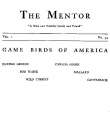You are here
قراءة كتاب The Mentor: Game Birds of America, Vol. 1, Num. 34, Serial No. 34
تنويه: تعرض هنا نبذة من اول ١٠ صفحات فقط من الكتاب الالكتروني، لقراءة الكتاب كاملا اضغط على الزر “اشتر الآن"

The Mentor: Game Birds of America, Vol. 1, Num. 34, Serial No. 34
NEST
This picture was taken by leaving the camera set all night. The bird itself pulled a thread which released the shutter early in the morning.
In my notebooks the nest of the ruffed grouse figures as a hollow in the ground, lined with dead leaves or pine needles. The eggs range from seven to twelve; in one case fifteen. The mother does not commonly cover them on leaving the nest; although a bird was once seen to do so by dropping straws and leaves on her back and then sliding out from under.

GROUSE
A favorite drumming log and trysting place.
What keeps the eggs from harm for weeks in the open woods? The grouse often brings off her young safely not far from the home of hawk, crow, or fox. Does the mother bird leave no scent by which her many four-footed enemies can find her? In one case, at least, well trained pointer and setter dogs could not find the bird on the nest, even after she had walked away and returned to it. Sometimes a dog or a fox blunders on the nest, and then the mother, every feather on end, flies at him in an attempt to drive him away; but this does not scare or deceive cunning Reynard, and in an instant his mouth is full of eggs. Sometimes a prowling cat catches the mother on her eggs at night, and that ends the family history; but in the majority of cases the eggs safely hatch.
The little ones all come from the shell together, and are fully equipped to find their own living. They need the mother only as guard, defender, and shelter. When they pop out of the eggs they leave the nest forever, and thenceforth they are at home in Robin Hood’s barn, and sleep wherever weariness or night overtakes them. A little roving band of downy, brownie, striped chicks, they keep close together, running here and there, always hunting, picking insects from grass, ground, and foliage; while the mother, stalking behind, herds them along with soft and gentle calls, acting as rear guard, to give warning of any enemy that may be upon their trail, to lead the destroyer away if she can, to defend them with her life if she cannot, and to brood them beneath her maternal breast whenever they are wet, cold, tired, or sleepy. Wherever night finds them there they snuggle down to sleep, protected from cold and storm by her tireless devotion. Probably the little ones do not leave much scent; but the fox, raccoon, mink, weasel, dog, and cat may cross their trail at any moment, crows, owls, and hawks menace them; yet commonly about half of them escape all danger and grow and thrive while the summer waxes and wanes. They learn to fly by the end of the first week. Before they are half grown they leave the ground at night, and roost with the mother in the trees.

A YOUNG GROUSE
This grouse was but nine months old. At this age the male is not distinguishable from the female.
When the “leaves begin to turn” the well grown brood seeks the wild grapevines and the wild apple and thorn trees that it may eat the fruit. When the first heavy snow falls the few that have safely run the gantlet of the guns squat beneath the low-spreading branches of some evergreen tree and calmly allow the snow to cover them if it will. They are ready for winter now, and have donned their snowshoes. What! really? Yes, actually. They have grown horny processes on both sides of the toes which will help to support their weight on packed snow or thin crust, and they are perfectly at home on or under the snow. If a crust freezes over them, they make their way beneath it, feeding on twigs and ground vegetation until they can break out. When pursued they dive from on wing into the snow, and


